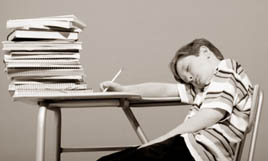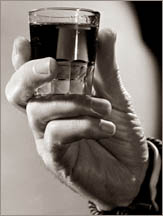
Head injuries : Don't take it lightly

* Total number of trauma patients admitted to the Accident Ward
annually : 100,000
* Out of 100,000 patients total number of patients admitted due to
road accidents : 26,000
* Out of 26,000 patients with head injuries (30%) : 7,800
* Out of 75 patients with all accidental injuries 20 are admitted
daily due to head injuries.
* Surgeries on head injuries performed at the Neuro -Surgical theatre
monthly 75.
* Five patients with severe head injuries are operated daily.
* Most deaths due to accidents (severe head injuries) reported in the
Neuro-trauma Intensive Care Unit.
by Shanika Sriyananda
She lies on the hospital bed helplessly. The growing pain in her head
has not answered even to heavy painkillers. She still feels that there
is bleeding inside her skull.
Tears pour down from her eyes. Thirty eight- year-old Sanjeevani
wants to disclose her story but in fear of another nightmare assault
prevents her from telling the tale. After a moment of silence she broke
into tears and was ready to tell her story.
The family life of this mother of three grown-up children went
peacefully. Doing a respectable job, her husband was very kind and held
the responsibilities as a good husband. Sanjeevani believed him and
planned the future of their children carefully.
But, the day she came across her beloved husband's 'love affair'
hopes for a better future shattered and now their marriage is on the
rocks.
No need to explain the fights between them and the agony that she
went through. She is now simply a victim of domestic violence. No
arguments... no explanations... and no kind appeals... her husband
answered them all by assaulting her with heavy objects or wooden poles.
She is now with a severe head injury due to the last assault by her
husband. Bleeding from head to toe and unconscious, she was taken to a
nearby medical centre but was rejected treatment due to the heavy
bleeding and was asked to be admitted to the Accident Service of the
Colombo National Hospital.
Today, she has been added to the list of patients with head injuries
at the Accident Ward not because of the common head injuries due to road
accidents but as a result of the cruelty of her own husband.
"Most of the accidents, especially like these can be preventable.
Generally accidents are not accidental and like other diseases accidents
occur due to some reasons. That reason may be in a particular person due
to negligence or may be due to environment", Director Accident Dr. Anil
Jasinghe says.
According to Dr. Jasinghe, the most important factor is that most of
the head injuries can be prevented.
One of the main causes for head injuries in Sri Lanka is road
accidents. Out of all the indoor patients a significant number of
patients with head injuries are due to road accidents. Out of them the
majority are pedestrians.
Dr. Jasinghe says that most of the head injuries occur on roads and
also in work places, which are due to not following the safety
standards. " Most of the work places like factories and construction
sites are not safe for workers. Majority of patients with severe head
injuries are admitted to the Accident Ward due to accidents in their
work places", he adds.
The number of pedestrians with head injuries are increasing due to
their own carelessness when crossing the road and also the drivers. "
People just cross the road without giving sufficient time for the
drivers.
Even when you cross the road at the zebra crossing you must give a
few seconds notice to the drivers. The other thing is that the drivers
do not wait until the pedestrians cross the road. If they see a small
gap they try to drive through. These two factors cause more accidents on
the roads", he says.
Dr. Jasinghe says that the best advice for the pedestrians are taking
care of themselves when crossing the road and also to abide by the road
safety regulations. " The other most vulnerable category are the motor
cyclists, who do not wear helmets. But fortunately, compared to the
other South East Asian countries wearing helmets have become popular",
he says.
He says that the escalating number of accidents should be brought
down as it is a heavy burden on the government as well as the families
and the society. Especially, patients wi th head injuries consume more
health resources than any other injured victims.
"Out of all injuries, head injuries are the worst category because
its consequences are risky. Disability is the major problem. The
patients with head injuries will be unconscious and the quality of life
will be affected badly.
Especially the Sri Lankan families and societies are not yet geared
to take care of disabled persons, well. And also institutional and
domestic facilities for them are still lacking", Dr. Jasinghe said.
According to Dr. Jasinghe, the people with head injuries should be
brought to the nearest hospital within the first 24-hours.
******
What is head injury
Head injury is a trauma to the head, that may or may not include
injury to the brain. The incidence (number of new cases) of head injury
is 300 per 100,000 per year (0.3% of the population), with a mortality
of 25 per 100,000 in North America and 9 per 100,000 in Britain.
Head trauma is a common cause of childhood hospitalization. Common
causes of head injury are traffic accidents, home and occupational
accidents, falls, and assaults. Bicycle accidents are also a common
cause of head injury-related death and disability, especially among
children.
Types of head injuries
Head injuries include both injuries to the brain and those to other
parts of the head, such as the scalp and skull. Head injuries may be
open or closed. A closed (non-missile) head injury is one in which the
skull is not broken.
A penetrating head injury occurs when an object pierces the skull and
breaches the dura mater. Brain injuries may diffuse, occurring over a
wide area, or focal, located in a small, specific area.
A head injury may cause a skull fracture, which may or may not be
associated with injury to the brain. Some patients may have linear or
depressed skull fractures. If intracranial haemorrhage, or bleeding
within the brain occurs, a haematoma within the skull can put pressure
on the brain.
Specific problems after head injury may include:
* Skull fracture
* Lacerations to the scalp and resulting haemorrhage of the skin
* Traumatic subdural haematoma, a bleeding below the dura mater which
may develop slowly
* Traumatic extramural, or epidural haematoma, bleeding between the
dura mater and the skull
* Traumatic subarachnoid haemorrhage
* Cerebral contusion, a bruise of the brain
* Concussion, a temporary loss of function due to trauma
* Dementia pugilistic, or "punch-drunk syndrome", caused by
repetitive head injuries, for example in boxing or other contact sports
* A severe injury may lead to a coma or death
Common symptoms of head injury include those indicative of traumatic
brain injury:
* loss of consciousness,
* confusion,
* drowsiness,
* personality change,
* seizures,
* nausea and vomiting,
* headache,
* a lucid interval, during which a patient appears conscious only to
deteriorate later. Head injury may be associated with a neck injury.
Bruises on the back or neck, back pain, pain radiating to the arms is a
sign of cervical spine injury meriting spinal immobilization and
application of a cervical collar.
It is common for head trauma patients to have drowsiness but to be
easily aroused, headaches, and vomiting after injury. If exam and
consciousness are preserved, this is of no concern. But if these
symptoms persist more than one or two days, a CT of the head is needed.
In some cases transient neurologic disturbance may occur, lasting
minutes to hours and causing occipital blindness and a state of
confusion. Malignant post traumatic cerebral swelling can develop
unexpectedly in stable patients after an injury, as can post traumatic
seizures.
Recovery in children with neurologic deficits will vary. Children
with neurologic deficits who improve daily are more likely to recover.
Children who are vegetative for months are less likely to improve.
Most patients without deficits have full recovery. However, persons
who sustain head trauma resulting in unconsciousness for an hour or more
have twice the risk of developing Alzheimer's disease later in life.
Source: Wikipedia
Reducing your child's stress
 After all, kids don't have jobs to keep or bills to pay, so what
could they possibly have to worry about? Plenty! Even very young
children have worries and feel stress to some degree. Stress is a
function of the demands placed on us and our ability (or sometimes our
perceived ability) to meet them. After all, kids don't have jobs to keep or bills to pay, so what
could they possibly have to worry about? Plenty! Even very young
children have worries and feel stress to some degree. Stress is a
function of the demands placed on us and our ability (or sometimes our
perceived ability) to meet them.
Sources of Childhood Stress Pressures often come from outside sources
(such as family, friends, or school), but they can also come from
within. The pressure we place on ourselves can be most significant
because there is often a discrepancy between what we think we ought to
be doing and what we are actually doing in our lives.
Stress can affect anyone - even a child - who feels overwhelmed. A
2-year-old child, for example, may be anxious because the person he or
she needs to feel good - a parent - isn't there enough to satisfy him or
her. In preschoolers, separation from parents is the greatest cause of
anxiety.
Many professionals feel that a number of children are too busy and do
not have time to play creatively or relax after school. Kids who begin
to complain about the number of activities they are involved in or
refuse to go to activities may be signaling to their parents that they
are too busy.
It's a good idea to talk with your child about how he or she is
feeling about after-school activities. If he or she complains, talk
about the pros and cons of quitting one of the activities. If quitting
isn't an option, talk about ways that you can help your child manage his
or her time and responsibilities so that they don't create so much
anxiety.
Your child's stress level may be intensified by more than just what's
happening in his or her own life. Does your child hear you talking about
troubles at work, worrying about a relative's illness, or fighting with
your spouse about financial matters? Parents need to be careful how they
discuss such issues when their children are near because children will
pick up on their parents' anxieties and start to worry themselves.
Also, consider that complicating factors, such as an illness, death
of a loved one, or a divorce, may be causing your child's stress. When
these factors are added to the everyday pressures kids face, the stress
is magnified.
Even the most amicable divorce can be a difficult experience for
children because their basic security system - their family - is
undergoing a tough change. Separated or divorced parents should never
put kids in a position of having to choose sides or expose them to
negative comments about the other spouse.
Recognizing Symptoms of Stress It's not always easy to recognize when
your child is stressed out. Short-term behavioral changes, such as mood
swings, acting out, changes in sleep patterns, or bedwetting, can be
indicators of stress.
Some children experience physical effects, including stomachaches and
headaches. Others have trouble concentrating or completing schoolwork.
Still others become withdrawn or spend a lot of time alone.
Younger children may show signs of reacting to stress by picking up
new habits like thumb sucking, hair twirling, or nose picking; older
children may begin to lie, bully, or defy authority. A child who is
stressed out may also have nightmares, difficulty leaving you,
overreactions to minor problems, and drastic changes in academic
performance.
How can you help your child cope with stress? Proper rest and good
nutrition can help increase your child's coping skills, as can good
parenting.
Make time for your child each day. Whether he or she needs to talk or
just be in the same room with you, make yourself available. Even as your
child gets older, this "quality time" is important.
It's really hard for some people to come home after work, get down on
the floor, and play with their kids or just talk to them about their day
- especially if they've had a stressful day themselves. But by showing
interest in your child's life, regardless of your child's age, you're
showing your child that he or she is important to you.
Remember that some level of stress is normal; let your child know
that it's OK to feel angry, scared, lonely, or anxious. Let him or her
know that other people share his or her feelings.
Books are a great way to allow young children to identify with
characters in stressful situations and learn how they cope. Most parents
have the skills necessary to deal with their child's stress.
The time to seek professional attention is when any change in
behavior persists, when your child's stress is causing serious anxiety,
or when the behavior is causing significant problems with your child's
functioning at school or at home.
If you are unsuccessful after several attempts to get to the source
of your child's troubles, see your child's doctor and talk to the
counsellors and teachers at your child's school. These sources can lead
you to competent professional help. -
kidshealth.com
Why early drinking leads to later abuse
 People who start drinking alcohol at a young age are more likely to
drink a lot when they get older, and to get into trouble with it. That's
been known for a while and is not a surprise. People who start drinking alcohol at a young age are more likely to
drink a lot when they get older, and to get into trouble with it. That's
been known for a while and is not a surprise.
A new study, however, sheds light on one reason that early drinkers
often become heavy - or dependent - older drinkers. It's because they
are more likely to use alcohol as a "stress reducer" than do people who
began drinking at an older age. Alcohol, it seems, becomes an overused
tool for weathering the trials of adulthood if a person first uses it as
a young teenager.
Deborah A. Dawson, of the federal government's National Institute on
Alcohol Abuse and Alcoholism, analyzed the responses of nearly 27,000
people in a nationally representative survey of Americans and their
drinking habits.
The respondents, average age 43, were asked when they started
drinking, how much they drank now and whether they had experienced any
of 12 stressful events in the previous year, including the death of a
family member, financial crises and marital disruption.
Regardless of when people started drinking, alcohol use increased
with the number of stressful events a person experienced. People who
started drinking at 14 or younger and reported six or more "stressors"
in the previous year consumed an average of six drinks a day - five
times the amount of similarly stressed people who started drinking at 18
or older.
The early drinkers increased their alcohol intake 19% with each
additional stressful event, compared with only 3% by the later-starting
drinkers.
The trend of youthful drinkers growing into adults who rely on
alcohol to cope was evident even when the scientists considered only
events that heavy drinking was not likely to have caused - such as the
death or illness of a family member or a change in work hours.
Washington Post
|


